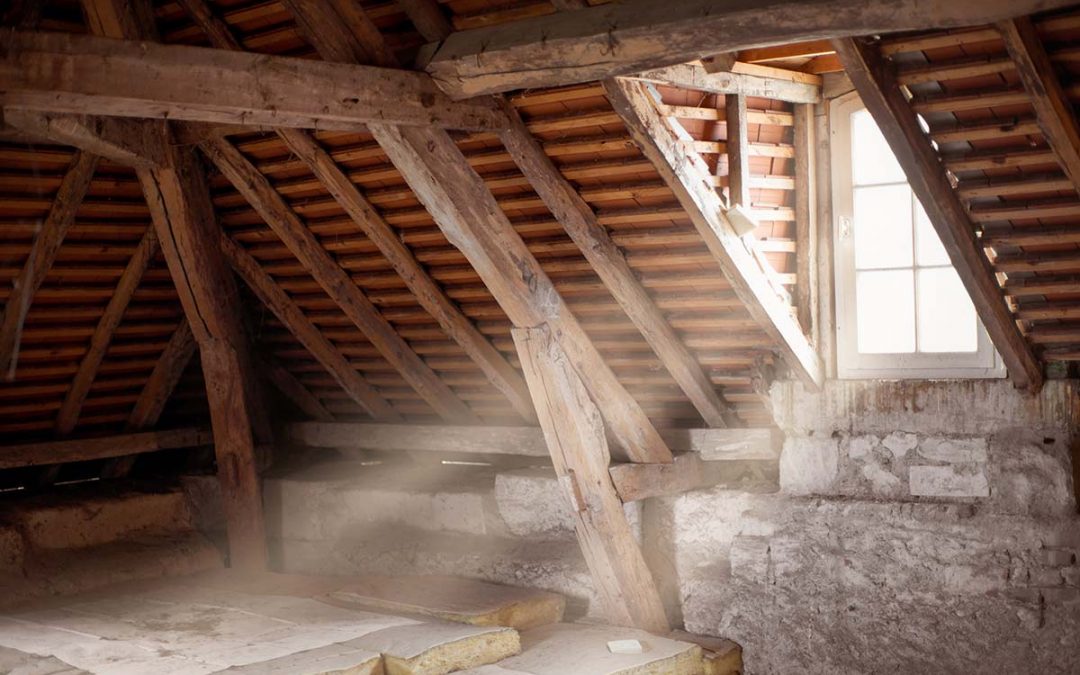The attic space is probably one of the most neglected and misunderstood spaces in your home. It is the space between the top floor ceiling and the roof. The attic holds the insulation that keeps you warm in the winter and cool in the summer. It is the space that conceals the framing members for your roof design and support. The size of your attic is dependent upon the slope of the roof and the floor area the roof covering is protecting.
To most, the attic is the space above the ceiling and below the roof, it is usually always dark, there is a small square hole with a lid over it, somewhere in the upper floor ceiling level, usually inside a closet, and there’s not much to see when you poke your head through this hole and into the attic space. But the attic is a buffer zone between your living space and the great outdoors above you. The attic space is continually dealing with moisture from your living space below, the moisture enters the attic through warm humid air that is continually seeping through penetrations in your ceiling. Some of these penetrations are from, pot lights, ceiling fans, plumbing pipes and stacks, bathroom fans and exhaust venting. All these fixtures penetrate the plastic
Early signs of high humidity in the attic can be detected by probing with moisture

Excessive moisture in your attic can weaken the roof, make insulation ineffective and damage the ceiling below; excessive moisture can come from the roof or from indoor humidity, sometimes it is difficult to determine just where it is coming from. Sometimes you may be able to spot a leaky roof by investigating the attic space during a rainstorm. Look for water running down the rafters and accumulating on top of the insulation. These areas will look somewhat darker. Also, during a winter freezing condition, frost will build up on the underside of the roof deck. I have seen this many times, and in severe cases, the frost can get up to three-quarters of an inch thick. I have seen it cover the roof underside sheathing in the corners or dead air spaces as large as 8′ x 15′ area. When this melts during a Chinook or a spring thaw, there will be several buckets of water resting on the attic side of your plastic air barrier looking for a hole to run through and damage the living space below. Sometimes this water will run down the wall and accumulate on the floor in one of your bedrooms or the living space. Over a short period, this condition will damage your roof, cause the shingles to prematurely wear out and render your insulation ineffective, elevating your heating costs. Much damage can be done through poor attic ventilation.
As you can see in photo #1, the insulation is also touching the underside of the roof deck. This is your primary cause for ice damming. Insulation that is full of moisture and touching the underside of your roof causes a thermal bridge. A thermal bridge is a path for heat or cold to travel from one area to the other commonly known as conduction. This thermal bridge will transfer the heat from the ceiling surface below to the underside of the roof. This heat transfer will cause the snow on the roof above to melt, and the meltwater will refreeze over the cold soffit area. This causes an ice dam which inhibits the drainage of any subsequent meltwater. This water will back up and get under the shingles and re-freeze, causing the shingles to lift and also do damage to the roof decking underneath.


In photo #2 and photo #3, you can see a band of light running across the roof wall intersection of this attic. If you look into your attic and you see something similar to this, and the air and the framing feels dry, there is a good chance that you have a well-ventilated attic. The light is coming up through the vented soffit and over the top of the insulation. This is your ideal condition, anything less would warrant further investigation.

